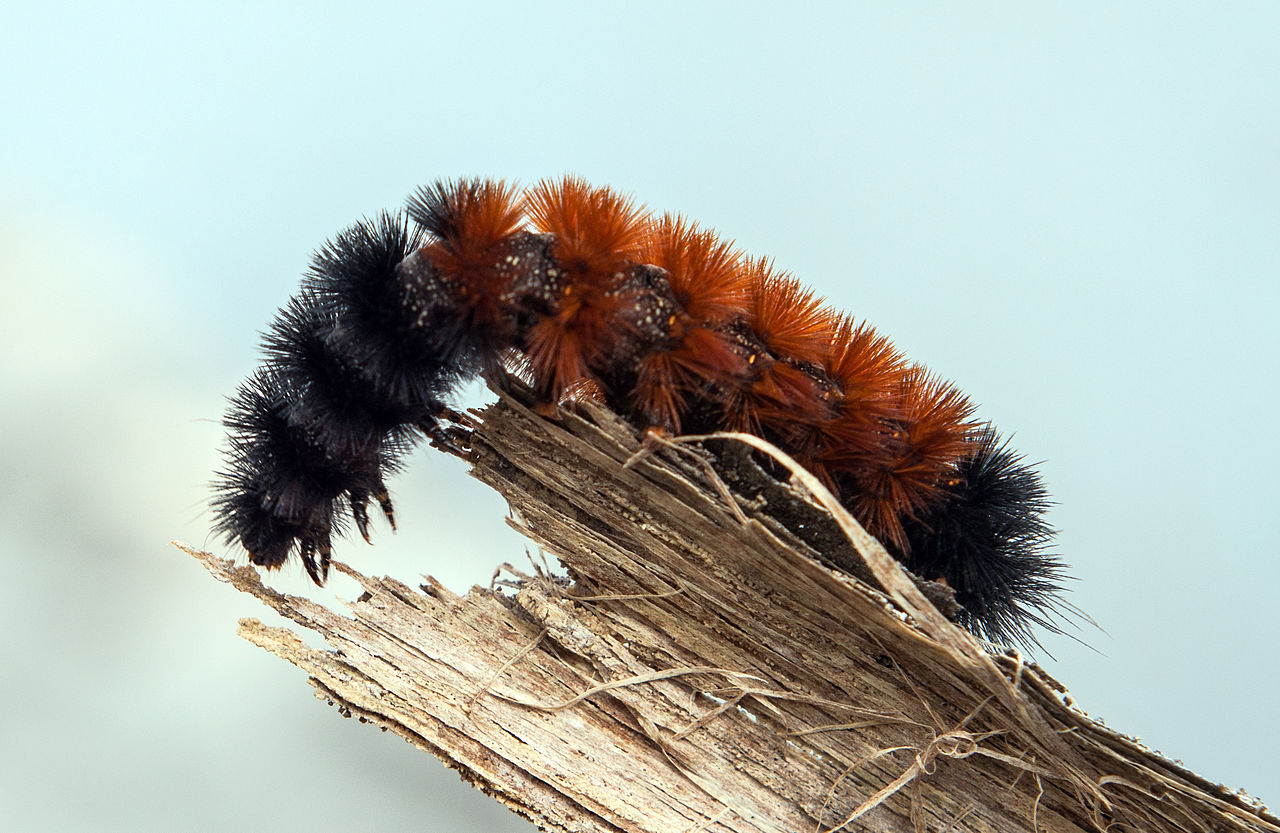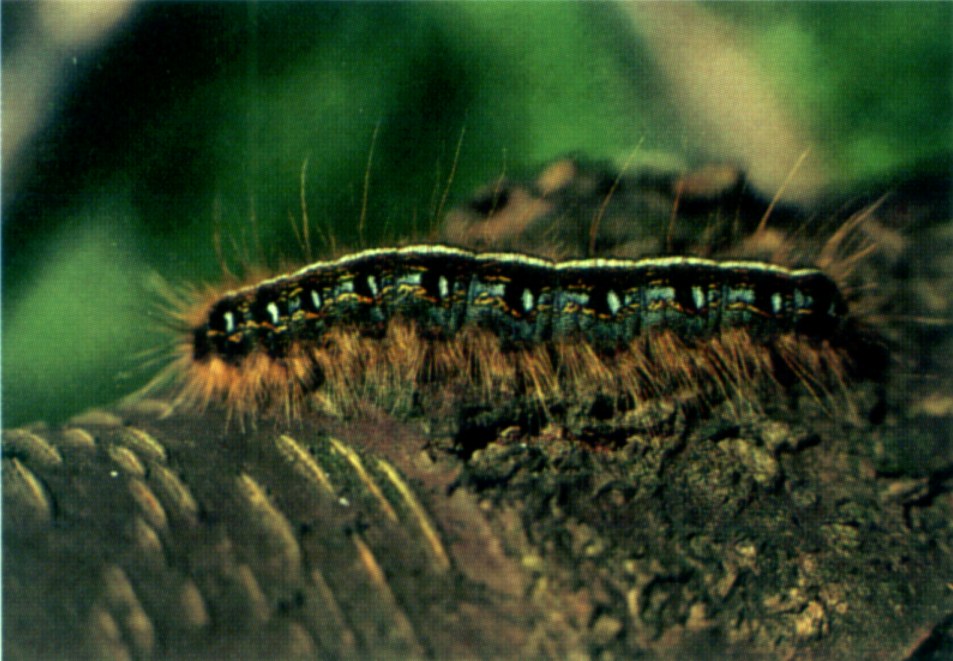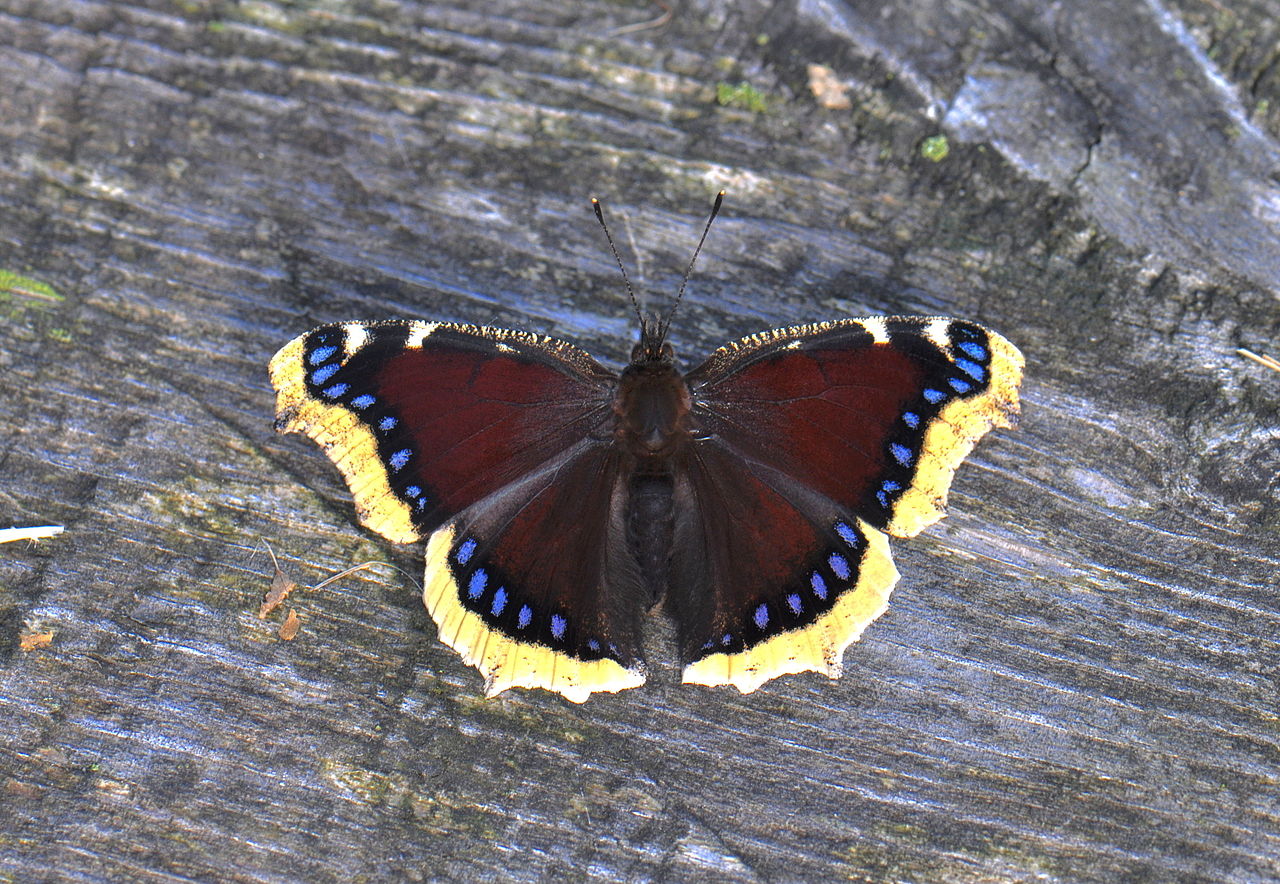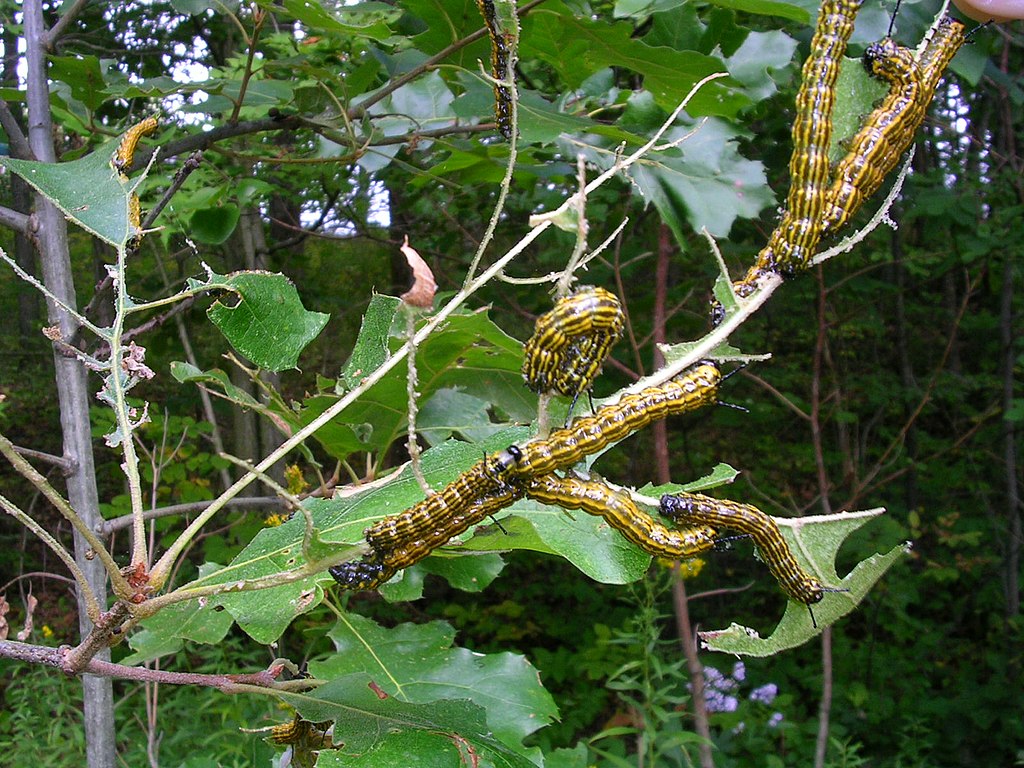As somebody undoubtedly learned, that's not the caterpillar that's a major pest on Rose of Sharon (the hibiscus leaf caterpillar), which is green, or the one that's a major nuisance on Rose of Sharon (the Saddleback or Packsaddle), which is green and brown. What could it be?
Not knowing where the reader is, I have no real idea. The good news, though, is that in the Eastern States a black and orange caterpillar on Rose of Sharon is not likely to be a problem, unless it's a newly introduced nuisance species someone smuggled in while we were busy panicking about coronavirus. Here's a Wikipedia link-o-rama to prove it. None of the big showy larvae is a real problem and the small one most likely to be seen in May is actually a friend to the hibiscus bush.
Several caterpillars in the Eastern States can be black and orange at some stages. The ones I've seen in May were little Baltimore Checkerspot butterfly larvae, which aren't big enough or common enough to be a serious pest on anything. They have bright colors and stiff bristles to discourage hungry birds. They're one of several baby butterflies whose bristles are shaped like those of stingingworms, but contain no venom. They usually eat smaller plants, mostly swamp weeds but sometimes plantain and other lawn weeds. In late summer they sometimes estivate in little hammocks of silk spun on leaves, which might lead them to explore a hibiscus bush in a really wet year, but they tend to stay near the ground.
 | ||||||||||||||||
The adults are basically black with orange and white spots above, black-white-and-orange checkered below:
 |
| Photo donated to Wikipedia By D. Gordon E. Robertson - Own work, CC BY-SA 3.0, https://commons.wikimedia.org/w/index.php?curid=33871430 |
Baltimores are scattered all over Eastern North America. Spread out, as shown, their wingspan can be more than 2.5 inches (7cm) but is usually less than that. They were probably always rare and are gravely endangered in Maryland, where they are the Official State Insects. Their need for weeds, as food and habitat, makes them casualties of glyphosate spraying; they've always been a favorite food source for little parasitic wasps.
Another black and orange caterpillar that might be found almost anywhere, but is usually found in late summer or autumn and usually stays close to the ground, is the very common and popular Woolly Bear, one of the "Bear" caterpillars that grow up to be "Tiger" moths:
 |
Woolly Bears eat almost anything, specifically seeking plants that are toxic to internal parasites when they are troubled by such, and otherwise nibbling on what they find. They never become a pest on anything. The stiff hairs can make sensitive skin itch, but are neither sharp nor venomous. This is one of the species that can even survive being kept as pets by primary school children; since the caterpillar's defense is to curl up in a ball with its fur outside, children may delightedly imagine that they're cuddly pets, although they probably tolerate being petted rather than enjoy it.
The moths are straw-yellow and, like the caterpillars, familiar to most people in Eastern North America.
 |
| Photo donated By Steve Jurvetson from Menlo Park, USA - A Moth is Born, CC BY 2.0, https://commons.wikimedia.org/w/index.php?curid=2483723 |
Very common in May in some years is the Eastern Tent Caterpillar. Basically a black caterpillar with white and pale blue markings, in the final stage before it pupates it grows a coat of soft ginger fur, especially along the sides.
 |
| Photo is Public Domain, https://commons.wikimedia.org/w/index.php?curid=121771 |
These very sociable and well adapted caterpillars are one big lesson in the hazards of population density. Every ten years or so they overpopulate, defoliate their host trees, and become a major nuisance in the part of the Eastern States suffering the species population explosion. Then after one or two years when having little furry squishy things everywhere is a nuisance and seems likely to endanger the trees (which can survive being stripped once in a year, with little loss even to fruit crops), the caterpillars suffer plagues of insect diseases, die off, and seem rare. Then the cycle repeats.
Tent caterpillars live in families. The first few to emerge from a mass of eggs laid on a fruit tree twig begin to find food and build a nest of silk in a fork of the tree. The ones who emerge later follow the bigger ones' lead. They spend a lot of time grooming one another's fur and will die if they have to spend much of their caterpillar lives without this grooming, probably from suffocation.
 |
| This photo donated By J.R. Carmichael - Own work, Public Domain, https://commons.wikimedia.org/w/index.php?curid=5671680 , shows a typical brood at home, resting and grooming one another. The nest has separate layers of silk through which the caterpillars can move ina nd out. |
They like paddling in very shallow water to cool off, but can drown in deep water. They are sensitive to temperature, curious, and extremely nearsighted, all of which traits can make them quite annoying to humans as they will follow pedestrians and bicyclists across hot pavement, looking for shade, and crawl up humans' legs, exploring. Despite these tiresome habits they are mostly harmless unless swallowed--they eat mostly cherry and other Prunus leaves, and acquire that blue color from cyanide. (A herd of pregnant mares who inadvertently ate caterpillar-infested grass lost their foals in a cyanide reaction.) Before pupation most of them are about two inches long--not especially large caterpillars, but much bigger than most of the other caterpillars we see in early May. During the last few days before pupation, although they don't actually eat much, they explore everything. You might find them exploring your house or car.
When they grow up these caterpillars become cocoa-brown moths, and do a much better job avoiding humans than they did as caterpillars.
People often search for questions like "how to kill tent caterpillars." If you want to protect newly planted trees you can knock them down and whack them with a stick, but otherwise there's no need to kill tent caterpillars. Nature has been taking care of this species for a long time.
Pipevine swallowtail caterpillars eat the leaves of vines in the genus Aristolochia. Depending on their age and the climate in which they grew up they can be black, orange, black and orange, or brown. Here is a typical black and orange individual:
 |
| Photo donated By Meganmccarty - Own work, Public Domain, https://commons.wikimedia.org/w/index.php?curid=5184926 |
In hotter climates the proportions of colors reverse, and the pattern changes:
 |
| Photo donated By Geoff Gallice from Gainesville - Pipevine swallowtail caterpillarUploaded by Ainali, CC BY 2.0, https://commons.wikimedia.org/w/index.php?curid=12168046 |
The harmless excrescences may make the caterpillar look more unappetizing to predators--more like certain millipedes that are even more inedible than the caterpillar is. It looks much prettier as an adult:
 |
| Photo donated By Greg Hume - Own work, CC BY-SA 3.0, https://commons.wikimedia.org/w/index.php?curid=19840463 |
The Pipevine Swallowtail is one of the smaller, more modest Swallowtails. Caterpillars usually stay on food plants, and don't bother climbing up bushes, but y'never know.
Mourning Cloak (Camberwell Beauty) butterfly caterpillars are another very active species. In most lights they look black, with simple spines and orange spots on the back. This photograph highlights the fine hairs so that they look white...
 |
| Photo By Hectonichus - Own work, CC BY-SA 4.0, https://commons.wikimedia.org/w/index.php?curid=56035118 |
They eat a lot of different bush and tree leaves; hibiscus is not documented as a host plant, but just before pupation these caterpillars explore almost anything. The butterflies are, if not the showiest, among the biggest, the longest-lived, and the most intriguingly adapted of all North American and European butterflies; their feats include having developed a transatlantic population.
 |
| Photo donted By Pavel Kirillov from St.Petersburg, Russia - The Mourning Cloak, CC BY-SA 2.0, https://commons.wikimedia.org/w/index.php?curid=46833959 |
They usually look black in flight, but again, in very bright light the upper wings seem dark brown and the underwings are mottled black and grey. Mourning Cloak butterflies can have wingspans up to 4 inches (20 cm), and the caterpillars can seem almost that long, but most are about two inches, like the others shown here.
Orange-Striped or Orange-Tipped "Oakworms" are the young of a moth called Anisota senatoria. There are two other species of Anisota that can almost be considered part of the same species. Though the moths are common they don't have an established "common name" in English. A. senatoria is one of the smaller of the big silk moths; after names like regalis and imperialis and the names of legendary giants were taken, this mid-sized moth was given a name just slightly less grandiose. If you call the big ones the Regal Moth and Imperial Moth and so on, this one would be the Senatorial Moth. Young caterpillars can look more yellow and green rather than orange and black. As they mature they become mostly black with orange pinstripes, about two inches long, with four soft fleshy "horns" at the front ends. They hatch in late summer, when they can devour oak leaves at an alarming rate without doing the trees any harm. They almost always stick to oak trees but occasionally fall out and wander about; like many caterpillars, just before pupating they're apt to wander.
 |
| Photo By Greg Dwyer - Own work, CC BY-SA 2.5, https://commons.wikimedia.org/w/index.php?curid=1070329 |
Adult male and female moths look quite different. Females are bigger and lighter-colored; males are reddish brown. This individual is female.
 |
| Photo By Tom Nicholaides -, CC BY-SA 1.0, https://commons.wikimedia.org/w/index.php?curid=27610952 |
Other black and orange caterpillars are fairly common. Several small species that look brown turn out, on close inspection, to be patterned in shades of black, orange, and other colors. However, in May a small caterpillar-like animal that's vividly black and orange is the flower garden's best friend, the Ladybird Beetle larva, or Aphid Lion. This bristly little mostly-black "worm" prowls among roses, hibiscus, and other bushes seeking aphids it may devour. It grows larger than you might expect a baby ladybug to be; though the beetles are only about a quarter-inch long, the larvae can be half an inch long.
This one is a young Asian Ladybird ("False Lady"). Though it will grow up to have drab brown wing covers rather than bright red ones, it's a "ladybug" and will eat aphids, scales, and other tiny pests like a good fellow (even after it grows up). Note its size relative to the raindrops around it.
 |
| Photo donated By Marcel Zurreck - Own work http://www.ref6.com/archive/2011/09/11/asian-ladybird-beetle-larva-harmonia-axyridis/, CC BY-SA 3.0, https://commons.wikimedia.org/w/index.php?curid=16432340 |
The more colorful "lady beetles" were dedicated to Our Lady, Mother Mary, by medieval Europeans because they're everybody's favorite beetles. They're useful to farmers, their exploring habits make them seem friendly to humans, and their bright polka-dotted wing covers look cheerful.
Whichever kind of black and orange caterpillar Somebody found on their Rose of Sharon or Northern Hibiscus, especially if it was not really a caterpillar at all, it's likely to be good news.
No comments:
Post a Comment